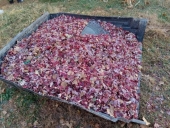posted 2 years ago
The short answer is two parts green to one part brown, by the weight.
In theory, here is the calculation to get the number:
Material C% N% C/N
Cardboard 40 0.1 400
Scraps 10-20 1-2 10
Assuming you have 10 lbs of Kitchen scraps containing 10% carbon and 1% nitrogen, to reach a C:N ratio of 30:1 in the compost, you will need n lbs of cardboard:
(10×0.1+0.4n)÷(10×0.01+0.001n)=30
n=5.4
In practice, it's less likely for people to weigh the materials out precisely. So just mix them up by the roughly 2:1 ratio and see what happens. since the cardboard is dry, I would make a slurry of kitchen scraps and soak the cardboard in to maximize the interacting surface area. The compost pile also needs to be protected somehow to avoid lost in moisture and heat. If it's not heating up then there is too much carbon; if it smells like ammonia, there is too much nitrogen.
Zone 6, 45 inches precipitation, hard clay soil









